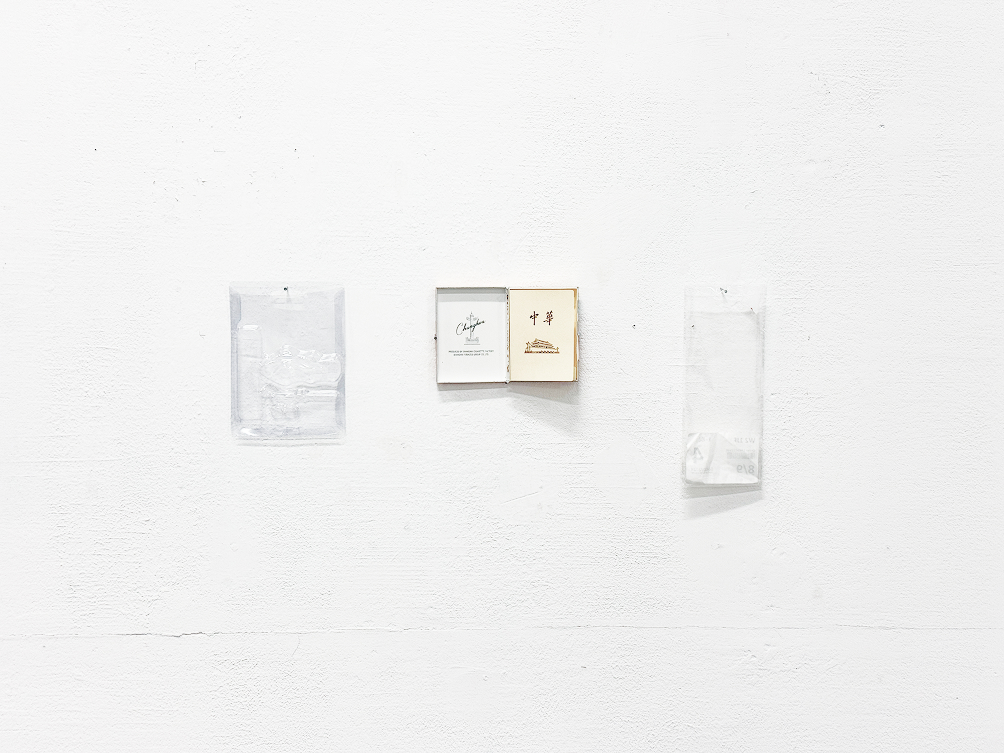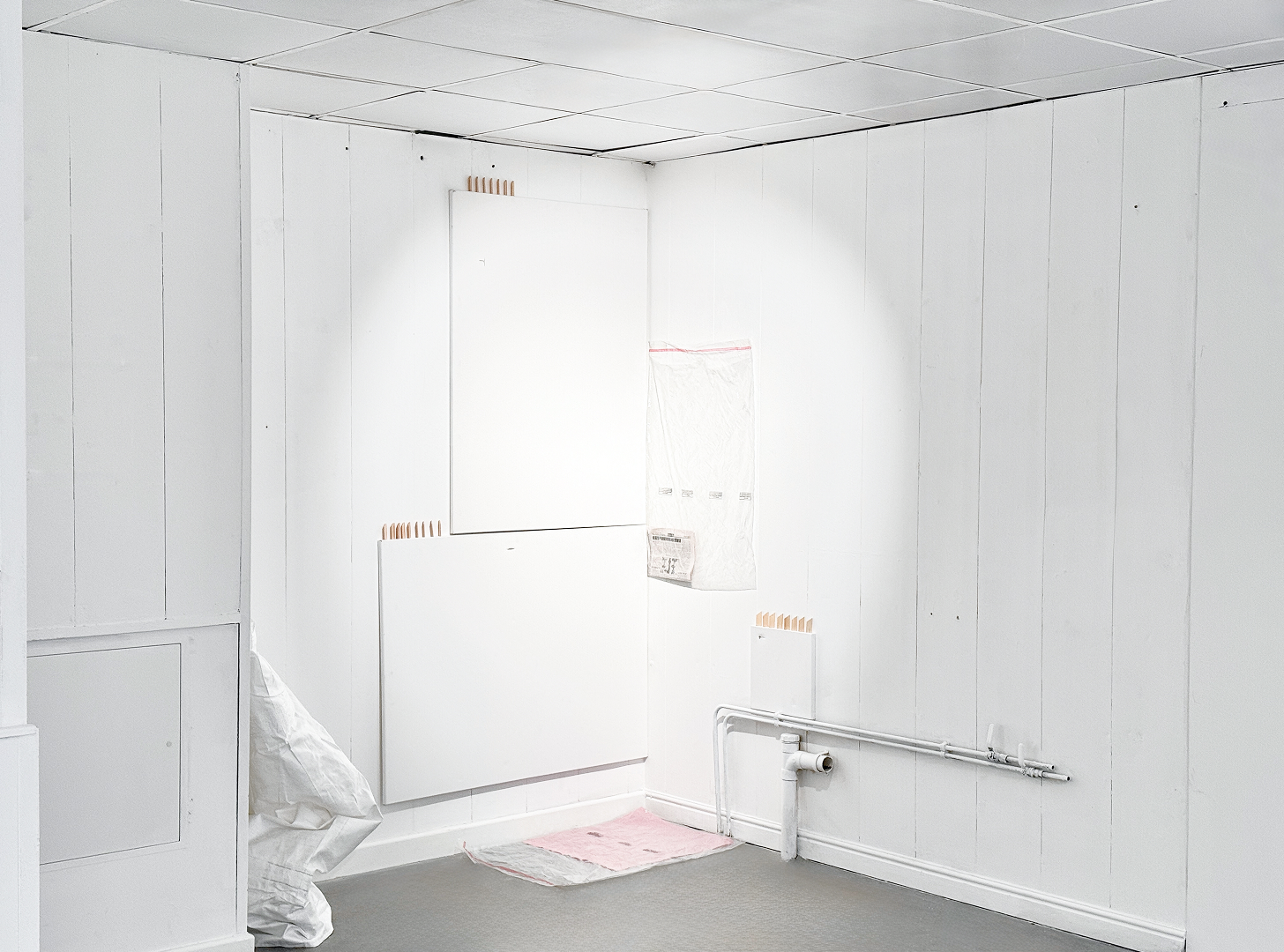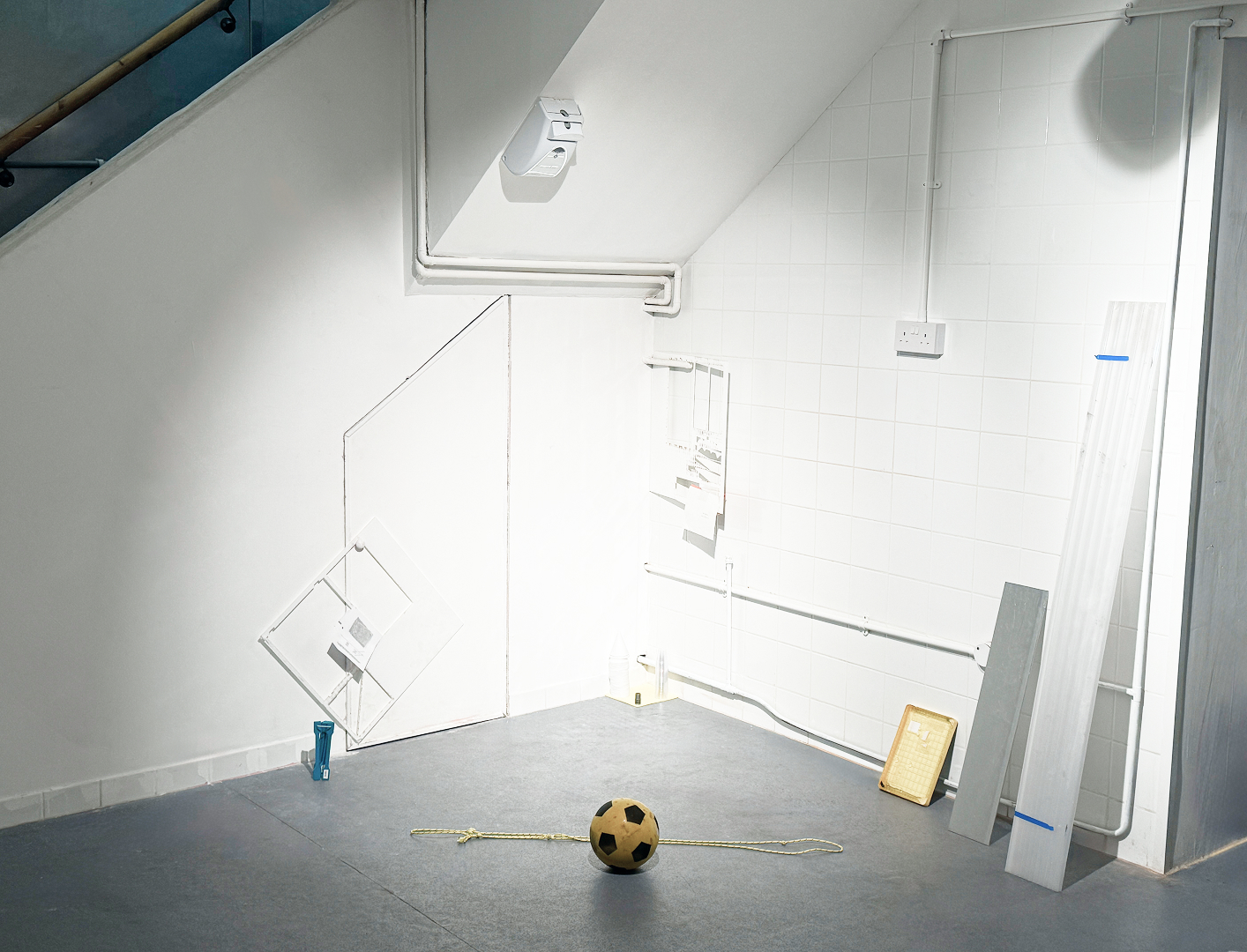There’s something ghostly about Jichi Zhang’s practice, but not in a haunted-house way — more like the feeling of breath fogging up a sheet of glass that’s already on the verge of disappearing. Born in Hohhot, China, in 2001 and now living and working in London, Zhang emerged through the alternative arteries of contemporary art: from Central Saint Martins’ experimental XD pathway to an Erasmus stint in Berlin. His work, however, barely reads as “sculpture” in any conventional sense. Instead, it hovers somewhere between surface and space, figure and residue. Using things that most people would throw away without a thought — plastic wrap, packaging remnants, industrial coverings — Zhang slows them down, listens to their fragility, and gives them just enough of a nudge to begin something without ever finishing it. In his hands, post-industrial detritus becomes a medium for gestures so quiet they border on the invisible, like a whisper meant not for your ears but your skin.
The works in am, his upcoming solo show at Absent Gallery in Guangzhou, stretch this ethos to near evaporation. Titled after a verb stripped of its action, am suggests a state of half-arrival, half-disappearance. These aren’t installations that confront the viewer — they barely assert themselves as objects. A plastic sheet curls inward from humidity, a crease folds like muscle memory, and a corner lifted by air trembles slightly before settling back into inertia. This is not drama; it’s duration. There’s no narrative arc, no visual climax, no clean takeaway. Zhang doesn’t force material into meaning — he waits. A sheet of plastic taped to a wall becomes a site of unlearning, its edges blurring between surface and space, presence and pullback. To stand before his work is to recalibrate one’s sense of time, to tune into the micro-tensions of the almost-nothing, the nearly-here.
And yet, there’s a kind of insistence beneath the delicacy. Zhang’s practice, though slow and quiet, is not passive. It refuses the spectacle economy of contemporary art with the elegance of a gesture barely made. He is spectacle-proof, not out of cynicism but conviction. His pieces dissolve the structures of visibility, undoing what it means for art to be “looked at.” Instead, they ask to be dwelt with, approached closely, but never owned or solved. In a group show, his work might be mistaken for residue left behind after takedown — until you notice the way the light holds it, or how your breath moves it slightly, and suddenly, there it is: not gone, but choosing to remain just barely. The slow collapse of form becomes not a failure, but a method. Zhang’s fragility isn’t precious — it’s political. It’s a mode of resistance against the clean, the clear, the complete. His practice says: to persist, we do not need to be loud. We need only to be there, trembling, translucent, and still.
Your 2024 publication in Scientific Reports on neural networks and gas molecular movement stands out. How does your scientific inquiry intersect with your artistic process?
The scientific paper and my artistic work come from different toolkits, but they share a fundamental concern: the search for structures that emerge from chaos, from noise. In the case of the neural networks and gas molecular simulations, I was exploring invisible patterns, how stochastic movement might still yield knowable outcomes under the right conditions. I think of my artistic process similarly. I work with discarded, soft, barely-there materials—plastic films, packaging, industrial sheeting- and instead of imposing form, I observe how they behave under light, air, and pressure. Both practices involve a kind of observation without domination. You set up conditions, then let something reveal itself. In that sense, science sharpened my sensitivity to systems, to the poetics of instability and emergence.
Your work spans diverse cities—London, Berlin, Suzhou, and Guangzhou. How has movement between these places shaped your approach to sculpture and installation?
Each city imposes its rhythm, its surface tension. Berlin taught me to value slowness and withholding—how not everything needs to be explained. London offers a collision of exposure and immediacy, pushing me to articulate more precisely what is at stake in a material gesture. Suzhou and Guangzhou, in contrast, carry a kind of ambient density, rich in texture, scent, and humidity. I think these shifts have tuned my relationship to space. In Guangzhou, something leans into you—heat, breath, architecture. In London, space recedes slightly; it waits for activation. I’ve learned to let work behave differently depending on where they are. My installations don’t try to “fix” a place; they try to listen to its atmosphere.
You’ve studied at two major art institutions—Central Saint Martins and UdK Berlin. What have you carried from these pedagogical environments into your current practice?
What I carry isn’t methodology so much as attitude. Central Saint Martins taught me how to act instinctively, to generate without over-theorising. UdK gave me a license to slow down, to undo habits, to let doubt become productive. But more than content, it’s the friction between these spaces that shaped me. Moving between institutions forced me to become more aware of context and to recognise how institutional language shapes artistic behaviour. That distance gave me freedom. It allowed me to practice without always needing to perform understanding.
As someone born in Hohhot and now immersed in European art institutions, how do your cultural roots inform your work? Are you ever conscious of expectations placed on artists from China working internationally?
My relationship with cultural identity is often indirect and subterranean. I don’t begin with it, but it finds its way into the work through texture, restraint, and rhythm. There’s a kind of internal logic in traditional Chinese aesthetics, about folding, layering, impermanence, that feels deeply aligned with how I think about material. I resist the idea of “representing” a culture. Instead, I try to embody a sensibility.
That said, there are expectations, some subtle, some overt. There’s often a desire for narrative clarity, for identity to be legible or marketable. I don’t necessarily reject those pressures, but I don’t conform to them either. I’m interested in opacity as a form of resistance. To let a work remain ambiguous, even unreadable, is a way of insisting on a more complex authorship, one not easily mapped by geography.
You participated in a dialogue with a highly institutional space in your 2024 group show, Re-Activate at The National Gallery. How do you negotiate the boundaries between traditional fine art institutions and more experimental or transient exhibition contexts like adventure playgrounds or public parks?
I see these contexts not in opposition, but as parts of a spectrum. The National Gallery gave me a framework of historical weight, of controlled space and regulated silence. That environment demands a certain kind of precision. By contrast, working in an adventure playground or a public park introduces unpredictability—air currents, children’s footsteps, and weather. The materials I work with are light plastics, translucent films, and I respond to these changes viscerally. So the work becomes more porous, more responsive.
In both cases, what I’m trying to do is similar: to stage conditions for attention, for slowness. The institution offers one kind of frame; public space offers another. My job is not to control either, but to allow the work to negotiate its presence within them. Sometimes the most delicate gesture, a fold, a flicker, can survive both.



